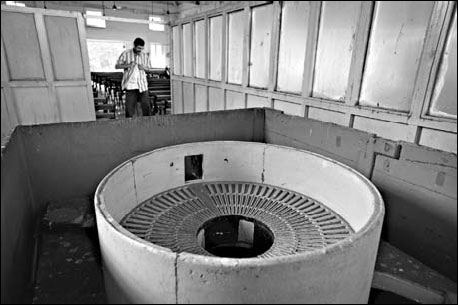In one religion, vultures welcome
|
Parsis want to maintain the practice of letting vultures dispose of dead bodies. A model of a Tower of Silence, where bodies are placed. Kuni Takahashi for The New York Times |
MUMBAI, India - Fifteen years after vultures disappeared from Mumbai's skies, the Parsi community here intends to build two aviaries at one of its most sacred sites so that the scavengers can once again devour corpses.
Dinshaw Rus Mehta, chairman of the Bombay Parsi Punchayet, said that if all goes as planned, vultures may again consume the dead by 2014.
"Without the vultures, more and more Parsis are choosing to be cremated," Mr. Mehta said.
The plan is the result of six years of negotiations between Parsi leaders and the Indian government to revive a centuries-old practice that seeks to protect the ancient elements - air, earth, fire and water - from being polluted by either burial or cremation. Along the way, both sides hope the effort will contribute to the revival of two species of vulture. The government would provide the initial population of birds.
"Most vulture aviaries have to spend huge sums to buy meat, but for us that's free because the vultures will be feeding on human bodies - on us," Mr. Mehta said.
The Parsis' religion, Zoroastrianism, once dominated Iran but was largely displaced by Islam. In the 10th century, a large group of Zoroastrians fled persecution in Iran and settled in India.
Fewer than 70,000 Parsis remain, most of them concentrated in Mumbai. Among the most valuable of their holdings are 21 hectares on Malabar Hill, one of Mumbai's most exclusive neighborhoods. Tucked into these hectares are three Towers of Silence where Parsis have for centuries disposed of their dead.
The stone towers are open-air auditoriums containing rings of marble slabs - an outer ring for dead men, middle ring for deceased women and inner ring for dead children. Bodies left on the slabs were consumed within hours by neighborhood vultures.
India once had as many as 400 million vultures, a population that thrived because of one of the largest livestock populations in the world and a ban on cattle slaughter. When cows died, they were set upon by vultures that left behind skin for leather merchants. But then came diclofenac, a common painkiller. In 1993 its use in India was approved in cattle. Vultures began dying from ingesting so much of the drug. Diclofenac's veterinarian use has since been banned.
Still, the numbers for three species have shrunk to only a few thousand. Desperate to maintain one of their most important rituals, Parsi leaders plan to build the aviaries near the Towers of Silence. They say they are waiting for formal approval.
Another concern is whether Parsis can be persuaded to stop using diclofenac. Nearly all of the bodies brought to the towers come from two Parsi hospitals, and doctors and family would have to certify that the deceased had not been given diclofenac in the three days before death.
"For 10 years, I have been trying to educate the community to turn off their cellphones before they go inside our most sacred fire temples, and I have failed," said Khurshed Dastoor, one of five Parsi high priests. "And now we think the community will give up diclofenac in a couple of months?"
Sruthi Gottipati contributed reporting.
The New York Times

























